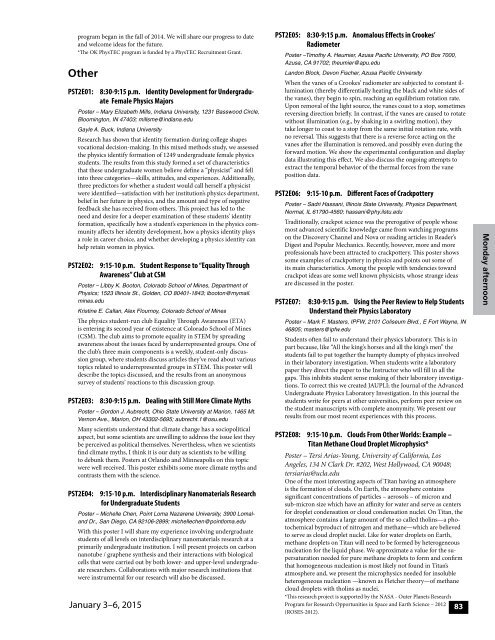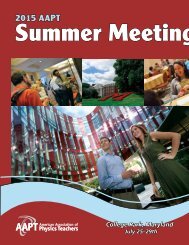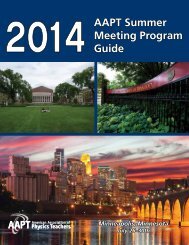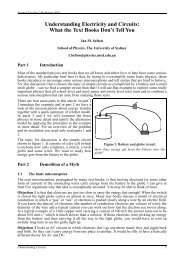final-program-12-23-14-3
final-program-12-23-14-3
final-program-12-23-14-3
Create successful ePaper yourself
Turn your PDF publications into a flip-book with our unique Google optimized e-Paper software.
<strong>program</strong> began in the fall of 20<strong>14</strong>. We will share our progress to date<br />
and welcome ideas for the future.<br />
*The OK PhysTEC <strong>program</strong> is funded by a PhysTEC Recruitment Grant.<br />
Other<br />
PST2E01: 8:30-9:15 p.m. Identity Development for Undergraduate<br />
Female Physics Majors<br />
Poster – Mary Elizabeth Mills, Indiana University, <strong>12</strong>31 Basswood Circle,<br />
Bloomington, IN 47403; millsme@indiana.edu<br />
Gayle A. Buck, Indiana University<br />
Research has shown that identity formation during college shapes<br />
vocational decision-making. In this mixed methods study, we assessed<br />
the physics identify formation of <strong>12</strong>49 undergraduate female physics<br />
students. The results from this study formed a set of characteristics<br />
that these undergraduate women believe define a “physicist” and fell<br />
into three categories—skills, attitudes, and experiences. Additionally,<br />
three predictors for whether a student would call herself a physicist<br />
were identified—satisfaction with her institution’s physics department,<br />
belief in her future in physics, and the amount and type of negative<br />
feedback she has received from others. This project has led to the<br />
need and desire for a deeper examination of these students’ identity<br />
formation, specifically how a student’s experiences in the physics community<br />
affects her identity development, how a physics identity plays<br />
a role in career choice, and whether developing a physics identity can<br />
help retain women in physics.<br />
PST2E02: 9:15-10 p.m. Student Response to “Equality Through<br />
Awareness” Club at CSM<br />
Poster – Libby K. Booton, Colorado School of Mines, Department of<br />
Physics; 15<strong>23</strong> Illinois St., Golden, CO 80401-1843; lbooton@mymail.<br />
mines.edu<br />
Kristine E. Callan, Alex Flournoy, Colorado School of Mines<br />
The physics student-run club Equality Through Awareness (ETA)<br />
is entering its second year of existence at Colorado School of Mines<br />
(CSM). The club aims to promote equality in STEM by spreading<br />
awareness about the issues faced by underrepresented groups. One of<br />
the club’s three main components is a weekly, student-only discussion<br />
group, where students discuss articles they’ve read about various<br />
topics related to underrepresented groups in STEM. This poster will<br />
describe the topics discussed, and the results from an anonymous<br />
survey of students’ reactions to this discussion group.<br />
PST2E03: 8:30-9:15 p.m. Dealing with Still More Climate Myths<br />
Poster – Gordon J. Aubrecht, Ohio State University at Marion, <strong>14</strong>65 Mt.<br />
Vernon Ave., Marion, OH 43302-5695; aubrecht.1@osu.edu<br />
Many scientists understand that climate change has a sociopolitical<br />
aspect, but some scientists are unwilling to address the issue lest they<br />
be perceived as political themselves. Nevertheless, when we scientists<br />
find climate myths, I think it is our duty as scientists to be willing<br />
to debunk them. Posters at Orlando and Minneapolis on this topic<br />
were well received. This poster exhibits some more climate myths and<br />
contrasts them with the science.<br />
PST2E04: 9:15-10 p.m. Interdisciplinary Nanomaterials Research<br />
for Undergraduate Students<br />
Poster – Michelle Chen, Point Loma Nazarene University, 3900 Lomaland<br />
Dr., San Diego, CA 92106-2899; michellechen@pointloma.edu<br />
With this poster I will share my experience involving undergraduate<br />
students of all levels on interdisciplinary nanomaterials research at a<br />
primarily undergraduate institution. I will present projects on carbon<br />
nanotube / graphene synthesis and their interactions with biological<br />
cells that were carried out by both lower- and upper-level undergraduate<br />
researchers. Collaborations with major research institutions that<br />
were instrumental for our research will also be discussed.<br />
January 3–6, 2015<br />
PST2E05:<br />
8:30-9:15 p.m. Anomalous Effects in Crookes’<br />
Radiometer<br />
Poster –Timothy A. Heumier, Azusa Pacific University, PO Box 7000,<br />
Azusa, CA 91702; theumier@apu.edu<br />
Landon Block, Devon Fischer, Azusa Pacific University<br />
When the vanes of a Crookes’ radiometer are subjected to constant illumination<br />
(thereby differentially heating the black and white sides of<br />
the vanes), they begin to spin, reaching an equilibrium rotation rate.<br />
Upon removal of the light source, the vanes coast to a stop, sometimes<br />
reversing direction briefly. In contrast, if the vanes are caused to rotate<br />
without illumination (e.g., by shaking in a swirling motion), they<br />
take longer to coast to a stop from the same initial rotation rate, with<br />
no reversal. This suggests that there is a reverse force acting on the<br />
vanes after the illumination is removed, and possibly even during the<br />
forward motion. We show the experimental configuration and display<br />
data illustrating this effect. We also discuss the ongoing attempts to<br />
extract the temporal behavior of the thermal forces from the vane<br />
position data.<br />
PST2E06:<br />
9:15-10 p.m. Different Faces of Crackpottery<br />
Poster – Sadri Hassani, Illinois State University, Physics Department,<br />
Normal, IL 61790-4560; hassani@phy.ilstu.edu<br />
Traditionally, crackpot science was the prerogative of people whose<br />
most advanced scientific knowledge came from watching <strong>program</strong>s<br />
on the Discovery Channel and Nova or reading articles in Reader’s<br />
Digest and Popular Mechanics. Recently, however, more and more<br />
professionals have been attracted to crackpottery. This poster shows<br />
some examples of crackpottery in physics and points out some of<br />
its main characteristics. Among the people with tendencies toward<br />
crackpot ideas are some well known physicists, whose strange ideas<br />
are discussed in the poster.<br />
PST2E07:<br />
8:30-9:15 p.m. Using the Peer Review to Help Students<br />
Understand their Physics Laboratory<br />
Poster – Mark F. Masters, IPFW, 2101 Coliseum Blvd., E Fort Wayne, IN<br />
46805; masters@ipfw.edu<br />
Students often fail to understand their physics laboratory. This is in<br />
part because, like “All the king’s horses and all the king’s men” the<br />
students fail to put together the humpty dumpty of physics involved<br />
in their laboratory investigation. When students write a laboratory<br />
paper they direct the paper to the Instructor who will fill in all the<br />
gaps. This inhibits student sense making of their laboratory investigations.<br />
To correct this we created JAUPLI; the Journal of the Advanced<br />
Undergraduate Physics Laboratory Investigation. In this journal the<br />
students write for peers at other universities, perform peer review on<br />
the student manuscripts with complete anonymity. We present our<br />
results from our most recent experiences with this process.<br />
PST2E08: 9:15-10 p.m. Clouds From Other Worlds: Example –<br />
Titan Methane Cloud Droplet Microphysics*<br />
Poster – Tersi Arias-Young, University of California, Los<br />
Angeles, 134 N Clark Dr. #202, West Hollywood, CA 90048;<br />
tersiarias@ucla.edu<br />
One of the most interesting aspects of Titan having an atmosphere<br />
is the formation of clouds. On Earth, the atmosphere contains<br />
significant concentrations of particles – aerosols – of micron and<br />
sub-micron size which have an affinity for water and serve as centers<br />
for droplet condensation or cloud condensation nuclei. On Titan, the<br />
atmosphere contains a large amount of the so called tholins—a photochemical<br />
byproduct of nitrogen and methane—which are believed<br />
to serve as cloud droplet nuclei. Like for water droplets on Earth,<br />
methane droplets on Titan will need to be formed by heterogeneous<br />
nucleation for the liquid phase. We approximate a value for the supersaturation<br />
needed for pure methane droplets to form and confirm<br />
that homogeneous nucleation is most likely not found in Titan’s<br />
atmosphere and, we present the microphysics needed for insoluble<br />
heterogeneous nucleation —known as Fletcher theory—of methane<br />
cloud droplets with tholins as nuclei.<br />
*This research project is supported by the NASA - Outer Planets Research<br />
Program for Research Opportunities in Space and Earth Science – 20<strong>12</strong><br />
(ROSES-20<strong>12</strong>).<br />
83<br />
Monday afternoon






